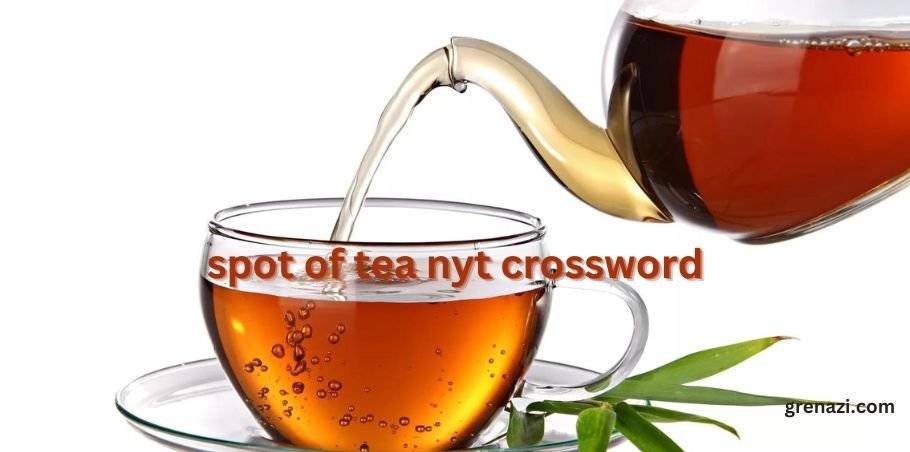spot of tea nyt crossword are a beloved pastime for many, with The New York Times (NYT) crossword puzzle standing as one of the most iconic. Whether you’re a seasoned solver or a newbie, the challenge of decoding tricky clues like “Spot of Tea” can be both frustrating and fun. But what exactly does this clue mean, and why does it show up so often in crosswords?
What is the NYT Crossword?
The spot of tea nyt crossword is more than just a daily diversion—it’s a cultural institution. Originally published in 1942, the NYT crossword has become one of the most challenging and respected puzzles in the world. It’s designed to be clever, engaging, and sometimes, downright tricky. This puzzle has a rich history, and over the years, it has evolved in complexity and style, pushing solvers to think outside the box.
The Rise of “Spot of Tea” as a Crossword Clue
“spot of tea nyt crossword” has emerged as a frequent crossword clue, popping up in various puzzle themes. It’s short, concise, and versatile, making it a go-to for crossword creators. But why this phrase in particular?
The answer lies in its dual meaning. While “Spot of Tea” might seem straightforward, it’s often used in a playful or metaphorical sense. The popularity of tea as a subject in both British and American cultures gives the phrase widespread recognition, which is essential for crossword clues.
Understanding the Clue “Spot of Tea”
At face value, “Spot of Tea” refers to a small serving of tea, typically a casual cup enjoyed during a break. However, the phrase also holds cultural weight, especially in the UK, where tea represents more than just a beverage. It’s a social activity, a tradition, and even a source of comfort.
In crossword puzzles, the clue can point to several meanings. It might reference tea itself or the act of having tea, but it could also imply something more abstract, such as a break or pause.
Common Answers for the Clue “spot of tea nyt crossword”
If you encounter “spot of tea nyt crossword” in a crossword puzzle, there are a few likely answers that might fit. Some common solutions include:
- “EARL” (referring to Earl Grey tea).
- “CHA” (a British slang term for tea).
- “BREW” (another synonym for tea).
- “CUP” (as in a cup of tea).
These variations are often dependent on the theme of the puzzle, the number of letters required, and how tricky the puzzle setter wants to be.
Why “Spot of Tea” is a Tricky Crossword Clue
Crossword setters love to use clues that have multiple interpretations, and “spot of tea nyt crossword” is a perfect example. While it seems straightforward, solvers often overthink or misinterpret the clue. Wordplay is central to crossword puzzles, and clues like this one are designed to mislead you just enough to make the solving process more rewarding.
British vs. American Terminology in Crossword Clues
Cultural nuances play a big role in crossword puzzles. What might seem like a common phrase in the UK can be completely foreign to American solvers and vice versa. For instance, “Spot of Tea” is a more familiar phrase in British English, while Americans might opt for “Cup of Tea.” This difference in terminology often adds an extra layer of challenge to solving crosswords.
Tips for Solving “spot of tea nyt crossword” Clues
When faced with a clue like “spot of tea nyt crossword,” it helps to:
- Consider the theme: Many NYT crosswords have themes that can guide you toward the right answer.
- Think of synonyms: Don’t just stick to the literal meaning—consider what else “Spot of Tea” might imply.
- Look at the letter count: Crossword answers are often restricted by the number of letters, so narrow down your options accordingly.
The Role of Tea in Popular Culture
Tea has been a beloved symbol in literature, films, and even everyday conversations. It often represents relaxation, sophistication, or an intellectual pause. This makes it a fitting subject for crossword puzzles, which themselves are a mental exercise enjoyed over a leisurely period, much like a cup of tea.
The Challenge of Cryptic spot of tea nyt crossword
For those who dabble in cryptic crosswords, the clue “spot of tea nyt crossword” might take on an even more complex form. In cryptic crosswords, clues contain hidden meanings, anagrams, or wordplay that can be quite tricky to decipher. “Spot of Tea” could be broken down into smaller word components, making the solving process even more intricate.
Crossword Solving Techniques
Solving crosswords is an art that requires practice, patience, and a few key strategies:
- Start with the easy clues to build confidence.
- Look for patterns in the crossword grid.
- Break down phrases into possible synonyms or alternative meanings.
How to Improve Your Crossword Solving Skills
To get better at solving puzzles like the spot of tea nyt crossword:
- Practice regularly.
- Use online resources like crossword dictionaries.
- Join crossword-solving communities where you can share tips and tricks with fellow enthusiasts.
The Role of Word Patterns in Crossword Puzzles
One of the most effective ways to solve crosswords is by recognizing word patterns. For instance, if you know that “Spot of Tea” is often a three-letter answer, your brain automatically narrows down the options. Patterns, both visual and linguistic, are crucial tools in a solver’s arsenal.
Frequently Asked Questions about NYT Crosswords
- Why are some clues harder than others?
Some clues involve more wordplay or obscure references, making them tougher. - How often does “Spot of Tea” appear in puzzles?
“Spot of Tea” appears occasionally, depending on the puzzle’s theme. - Are there other common tea-related clues?
Yes, terms like “brew,” “chai,” and “cup” often show up in puzzles. - What’s the hardest part of solving NYT crosswords?
The wordplay and misleading clues can be the trickiest aspects. - Can crosswords improve cognitive skills?
Yes, regular crossword solving is a great way to sharpen your brain.
Conclusion
The “spot of tea nyt crossword” clue in the NYT crossword is a perfect example of the blend of culture, language, and clever wordplay that makes solving crosswords so enjoyable. With practice and patience, even the trickiest clues can be deciphered, turning frustration into satisfaction.









